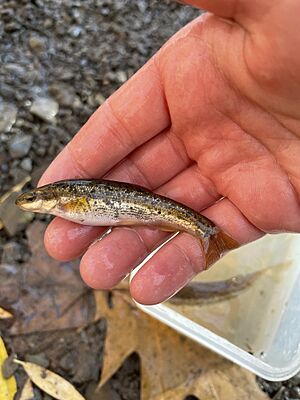Western blacknose dace facts for kids
Quick facts for kids Western Blacknose Dace |
|
|---|---|
 |
|
| Fish caught in Mississauga, Ontario. | |
| Conservation status | |
| Scientific classification | |
| Synonyms | |
|
Rhinichthys meleagris Agassiz, 1854 |
The Western blacknose dace (Rhinichthys obtusus) is a small, common freshwater fish. It belongs to the minnow and carp family, called Cyprinidae. These fish are known for their unique appearance and interesting habits.
Western blacknose dace have backs that are tan to dark brown. Their sides are lighter, and their bellies are a creamy color. You might see dark spots scattered on their backs and sides. A clear dark stripe runs along their side, from their nose to their tail. This stripe is dark brown in female fish. In males, it turns a rusty pink color when they are ready to lay eggs. Young dace have a very clear side stripe and a spot near their tail.
These fish have a snout that is quite long. Their mouth is slightly underneath their head. Even though it looks like they don't have scales, they do! Their scales are just very tiny and hard to see. Western blacknose dace usually grow to be about 2 to 3 inches long. Some can even reach up to 4 inches. They have a tail that splits into two parts, like a fork. They also have one fin on their back and another fin on their belly.
Where Western Blacknose Dace Live
Western blacknose dace live in many rivers and lakes in North America. You can find them in the upper parts of the Mississippi and Ohio River systems. They also live in the Great Lakes area. Their home range stretches from southern Canada down to northern Alabama and Georgia. They can also be found east to Lake Erie.
Young dace like to stay in shallow, calm areas. These spots often have soft, muddy bottoms. Older dace prefer streams with faster water. They like places with lots of rocks and hiding spots. This is because they are a food source for bigger fish. They usually live in water that is about 4 to 8 inches deep. They prefer bottoms made of gravel or small rocks. You might also find them hiding under large rocks in fast-moving parts of the stream.
Reproduction and Life Cycle
Western blacknose dace start to lay their eggs in spring. This can continue until mid-summer. The exact time depends on how warm the water is. They lay their eggs in areas with gravel bottoms. This is different from some other dace species.
These fish do not live very long, usually up to four years. Because of their short lives, they start to reproduce when they are about two years old. Unlike some other dace, the Western blacknose dace does not lay its eggs in the nests of larger minnow species.
What Western Blacknose Dace Eat
Western blacknose dace are mostly meat-eaters. What they eat changes as they grow older. Young dace mostly eat small insect larvae. These are often larvae of flies.
As dace get older, they still eat insect larvae if they can find them. However, a big part of their diet also includes small crustaceans called amphipods. Scientists think this change in diet happens because older dace move to different areas. These new areas might have more amphipods available to eat.



